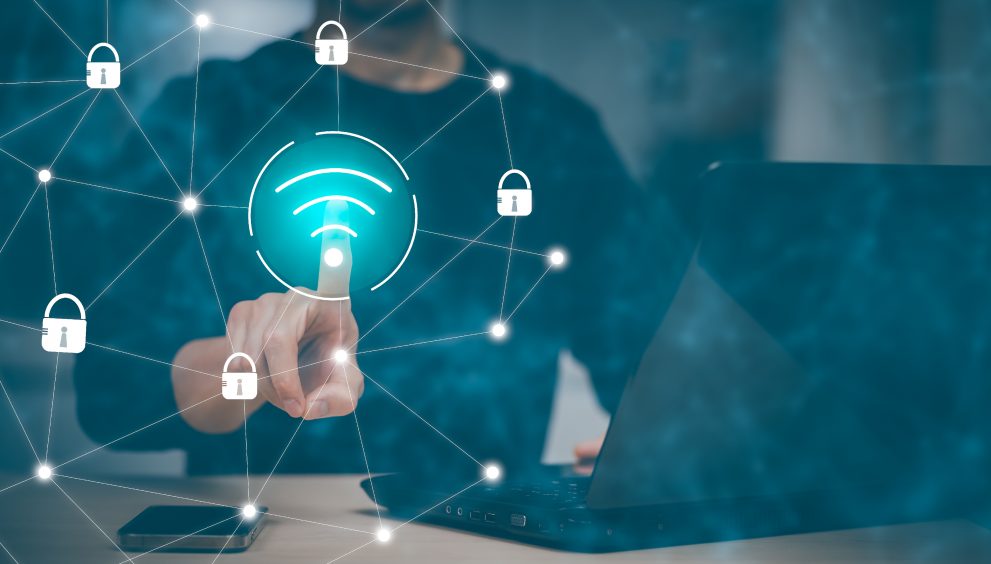Have you ever considered the hidden risks lurking behind your WiFi connection? These breaches often stem from vulnerabilities in network setups, rogue access points, or even simple human oversight.
The impact? Not just financial losses and damaged reputations; the legal repercussions for businesses and the personal privacy risks for individuals are harmed too.
To prevent leakage it is necessary to have a proactive approach. It means implementing strong encryption methods, keeping a vigilant eye on network activities, and addressing potential weaknesses. As technology advances, so do the tactics of cybercriminals. Understanding how a data security breach happens and deploying effective leakage prevention strategies are crucial for fortifying defences against these evolving threats.
Understanding WiFi Data Leaks
Understanding what constitutes data leakage in cyber security is crucial for implementing effective strategies to prevent leakages and mitigate risks.
Here are some common scenarios of WiFi data breaches:
- Weak Encryption Protocols: Inadequately encrypted WiFi networks can be easily compromised, allowing unauthorized access to sensitive data transmitted over the network.
- Unauthorized Access Points: Rogue access points set up by attackers mimic legitimate networks, tricking users into connecting.
- Man-in-the-Middle Attacks: Hackers intercept data transmitted between devices and networks, gaining access to sensitive information such as login credentials or financial data.
Risks and Consequences of WiFi Data Leaks
WiFi data leaks pose significant risks across personal and organizational levels, with profound implications for legal compliance, financial stability, and reputational integrity.
Impact on Personal and Organizational Data Security
Data leakage in cyber security exposes sensitive information to unauthorized access, compromising personal privacy and organizational confidentiality. Individuals may fall victim to identity theft, while businesses risk exposing proprietary data and customer information to cybercriminals. The breach of trust resulting from such incidents can irreversibly damage relationships with clients and stakeholders.
Legal and Compliance Implications
Data protection regulations, such as GDPR and CCPA, impose stringent requirements on organizations to safeguard personal data. Failure to comply with these regulations causing WiFi data leaks can lead to substantial fines and legal penalties.
Financial and Reputational Damage
The financial repercussions of WiFi data breaches extend beyond immediate losses from fraud or theft. Organizations may face operational disruptions, remediation costs, and decreased market trust, impacting long-term financial stability.
Reputational damage resulting from public disclosure of a data breach and cyber security issues can tarnish brands, leading to diminished customer loyalty and potential business decline.
Factors Contributing to WiFi Data Leaks
WiFi data leaks can occur due to various vulnerabilities and factors within network infrastructure and device security practices:
Weak Encryption Protocols and Outdated Security Measures
WiFi networks become vulnerable when encryption is weak or security measures are outdated. This makes it easier for cybercriminals to exploit vulnerabilities and access sensitive information.
Unauthorized Access Points and Rogue Networks
Malicious actors set up rogue access points to trick users into connecting, allowing them to intercept data and compromise devices. These unauthorized networks are especially risky in public places and corporate environments, where users may unknowingly expose their data to theft.
Insecure IoT Devices and Their Vulnerabilities
Many IoT devices lack strong security protocols, making them easy targets for cyber attacks. When compromised, these devices can provide attackers with entry points to infiltrate WiFi networks, potentially leading to data breaches and network compromises.
Leakage Prevention Strategies for WiFi Data Leaks
Securing WiFi networks against data leakage in cyber security is paramount to fortifying WiFi network defenses and mitigating the risks of data security breaches.
- Use Strong Encryption: Implement WPA3 (Wi-Fi Protected Access 3) encryption standards to secure data transmitted over WiFi networks. Avoid using outdated encryption protocols.
- Update Firmware and Software: Regularly update WiFi routers, access points, and connected devices with the latest security patches and firmware updates to address known vulnerabilities.
- Use Strong Passwords: Set unique, complex passwords for WiFi networks and change them periodically. Consider implementing two-factor authentication (2FA) for added security.
- Guest Network Segmentation: Separate guest WiFi networks from internal networks to restrict access to sensitive data and resources.
- Network Monitoring Tools: Deploy intrusion detection systems (IDS) and intrusion prevention systems (IPS) to monitor network traffic for suspicious activity and potential WiFi data breaches.
- Real-time Alerts: Configure systems to alert you in case of anomalous behavior like unauthorized access attempts or potential WiFi security threats.
Best Practices for Data Leakage Prevention
Adopting best practices like these is essential to prevent data security breaches:
- Security Awareness Programs: Conduct regular training sessions to educate employees about the risks of WiFi data leaks and safe browsing practices.
- Reporting Procedures: Establish clear procedures for employees to report suspicious WiFi network activity or potential security incidents.
- Policy Development: Develop comprehensive data security policies that outline acceptable uses of WiFi networks, data handling procedures, and consequences for non-compliance.
- Regular Audits and Compliance Checks: Conduct regular audits to ensure adherence to data security policies and compliance with industry regulations (e.g., GDPR, HIPAA).
- Encrypt Data at Rest and in Transit: Implement encryption protocols (e.g., AES-256) to protect sensitive data stored on devices and transmitted over WiFi networks. Use virtual private networks (VPNs) for secure remote access.
- Data Masking and Tokenization: Employ data masking and tokenization techniques to anonymize sensitive information and reduce the risk of exposure during transmission.
Secure Your WiFi with Quick Heal!
As WiFi networks grow, so do security challenges. Preventing a data security breach demands proactive measures like encryption, updates, and staff training, ensuring robust protection and trust in digital operations.
Quick Heal’s Wi-Fi Security feature provides a robust solution for preventing data leaks over Wi-Fi networks. To configure Wi-Fi Security, follow these steps:
- Open Quick Heal Total Security.
- On the Dashboard, tap Wi-Fi Security and enter the PIN.
- Select Wi-Fi Security to enable this feature.
Once Wi-Fi Security is enabled, it will continuously check the security status of the Wi-Fi networks you connect to, scanning for and addressing security vulnerabilities. Its proactive approach helps safeguard your personal and sensitive information from potential cyber threats while you navigate the digital world.
At just Rs. 1591 a year, ensure you are secure online with Quick Heal!
Related Products:


